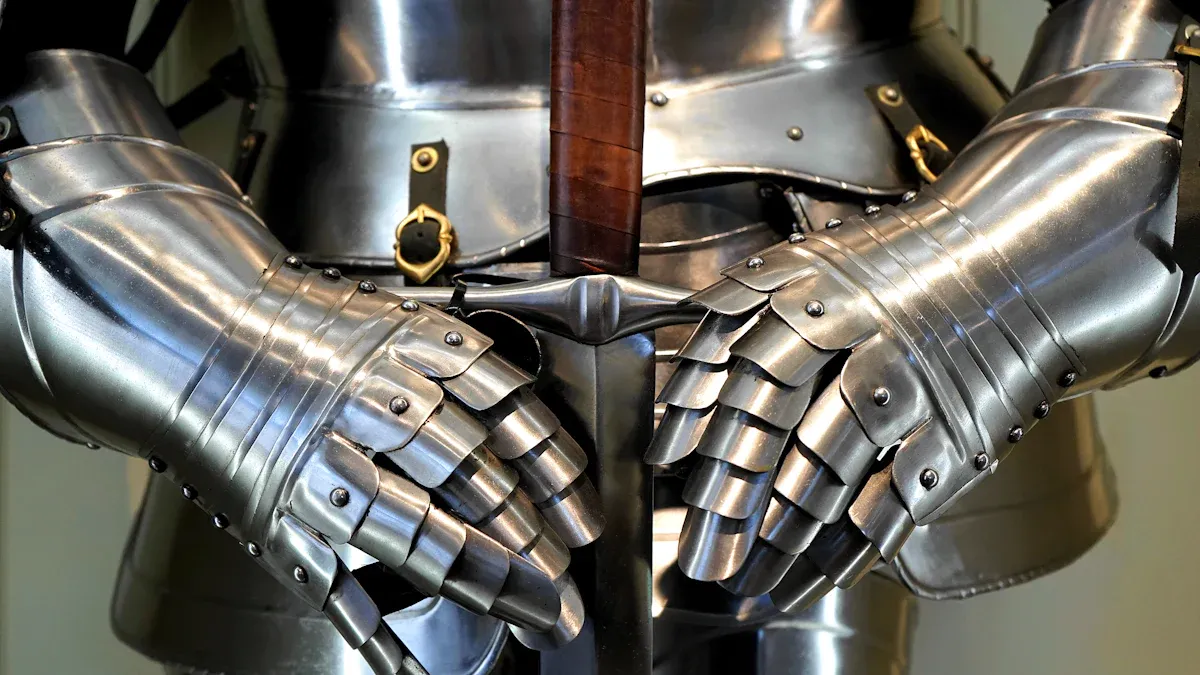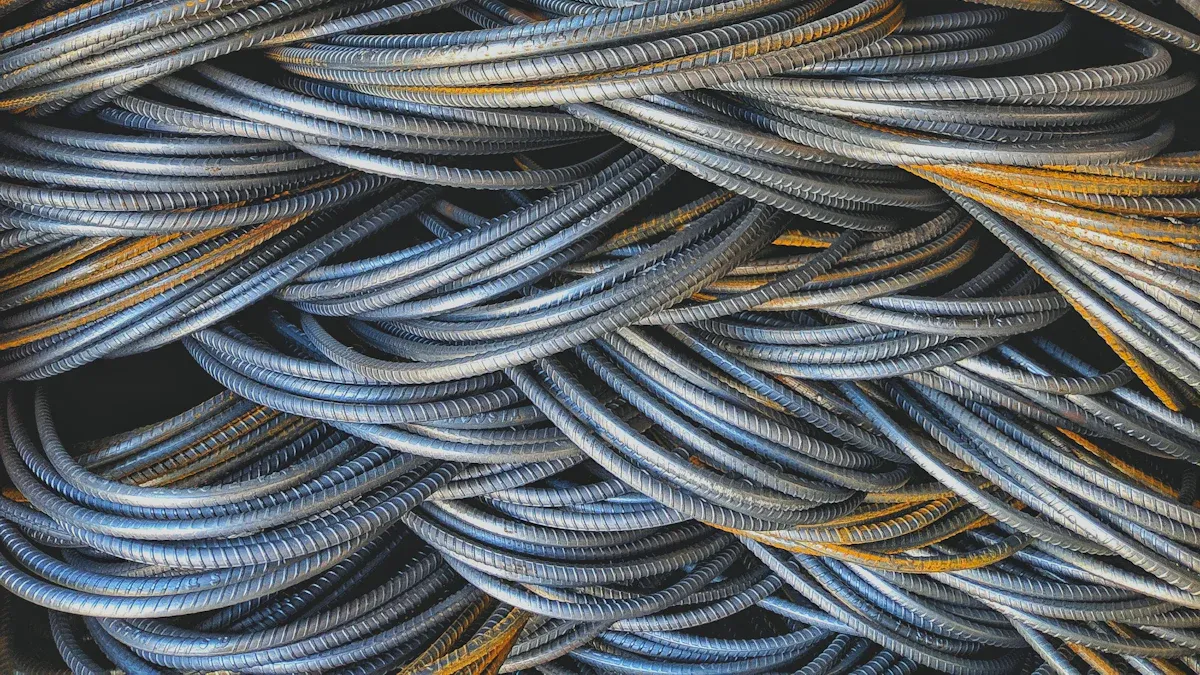
Is titanium stronger than steel? This question often arises in discussions about material properties, particularly in the context of titanium vs steel. While titanium exhibits remarkable strength-to-weight ratios, steel remains a formidable contender in terms of overall strength. In 2023, U.S. production of titanium alloys exceeded 50,000 metric tons, with the aerospace industry representing over 60% of that demand. As the global titanium market continues to grow, reaching a valuation of USD 27.91 billion, understanding the nuances between titanium vs steel becomes essential for industries that rely on their unique properties.
Key Takeaways
- Titanium is lighter than steel, making it ideal for applications where weight matters.
- Steel generally has higher tensile and yield strength, making it suitable for heavy-load applications.
- Titanium offers excellent corrosion resistance, especially in harsh environments like seawater.
- Steel is more cost-effective than titanium, making it the preferred choice for many industries.
- Titanium’s high strength-to-weight ratio benefits aerospace and medical applications.
- Steel’s versatility allows for easy fabrication and use in construction and manufacturing.
- When choosing between titanium and steel, consider weight, cost, and specific application needs.
- Both materials have unique advantages; understanding these helps in making informed decisions.
Properties of Titanium

Physical Properties
Titanium possesses several notable physical properties that contribute to its widespread use in various industries. Its density is relatively low, making it lightweight compared to many metals. For instance, commercially pure titanium (Grade 4) has a density of 4.51 g/cm³, while the popular titanium alloy Ti-6Al-4V has a density of 4.43 g/cm³. This lightweight characteristic is crucial in applications where reducing weight is essential, such as in aerospace and automotive sectors.
| Property | Commercially Pure Titanium (Grade 4) | Titanium Alloy 6-4 |
|---|---|---|
| Density | 4.51 g/cm³ (0.163 lbs/in³) | 4.43 g/cm³ (0.16 lb/in³) |
| Melting Point | 1660 °C (3020 °F) | 1604–1660 °C (2920–3020 °F) |
| Thermal Conductivity | 17.2 W/mK (119 BTU-in/h-ft-°F) | 6.7 W/mK (46.5 BTU*in/hr-ft²-°F) |
Mechanical Properties
The mechanical properties of titanium further enhance its appeal. Titanium exhibits a high strength-to-weight ratio, making it an excellent choice for applications requiring both strength and lightness. The hardness of commercially pure titanium (Grade 1) ranges from 70 to 74 on the Rockwell B scale. Additionally, the Young’s modulus for pure titanium is approximately 110 GPa, while titanium alloys like Ti-6Al-4V maintain a similar modulus but offer increased strength.
- Elastic modulus of pure titanium: approximately 110 GPa
- Typical commercial titanium alloy (Ti-6Al-4V): similar elastic modulus and higher strength
Corrosion Resistance
Titanium’s corrosion resistance is one of its most significant advantages. It performs exceptionally well in harsh environments, including high-chloride and high-alkali seawater. Commercially pure titanium outperforms its alloys in extremely corrosive conditions due to a higher proportion of corrosion-resistant TiO2 in its oxide film. However, it is essential to note that titanium is not entirely immune to corrosion. Under specific aggressive conditions, degradation can occur.
- Titanium shows excellent corrosion resistance in:
- High-chloride environments
- Acidic environments
- The presence of dual phases in titanium alloys can lead to increased pitting corrosion.
Understanding these properties of titanium is crucial when comparing it to steel. While titanium offers unique advantages, the choice between titanium vs steel ultimately depends on the specific requirements of the application.
Properties of Steel

Physical Properties
Steel is a versatile material known for its robust physical properties. It typically has a higher density compared to titanium, which contributes to its strength. For instance, the density of carbon steel is approximately 8.05 g/cm³, while stainless steel has a density of around 8.0 g/cm³. These values indicate that steel is significantly denser than titanium, making it a heavier option for applications where weight is less of a concern.
| Material | Density (g/cm³) |
|---|---|
| Stainless Steel | 8.0 |
| Carbon Steel | 8.05 |
Steel also exhibits a high melting point, generally around 1450 °C for various types, including low-carbon and stainless steel. This characteristic allows steel to maintain its integrity under high-temperature conditions, making it suitable for demanding applications.
| Material Type | Melting Point (°C) |
|---|---|
| Stainless Steel (Type 304) | 1450 |
| Low-Carbon Steel | 1450 |
Mechanical Properties
The mechanical properties of steel further enhance its utility in construction and manufacturing. Steel typically has an elastic modulus ranging from 190 to 210 GPa, which indicates its ability to deform elastically when subjected to stress. This property is crucial for structural applications where materials must withstand significant loads without permanent deformation.
| Steel Type | Elastic Modulus (GPa) |
|---|---|
| Carbon Steel | 190-210 |
| Stainless Steel | 190-210 |
| Alloy Steel | 200-220 |
Additionally, steel’s hardness varies depending on its composition and treatment. For example, carbon steel can achieve a hardness level that makes it suitable for tools and structural components. This adaptability allows engineers to select specific steel grades based on the requirements of their projects.
Corrosion Resistance
Corrosion resistance is a critical factor when choosing materials for specific environments. In marine settings, carbon steel shows poor corrosion resistance and is prone to rusting. This necessitates protective coatings to prolong its lifespan. Conversely, stainless steel, particularly grade 316, offers enhanced resistance to pitting and crevice corrosion, making it a preferred choice for marine applications.
| Material | Corrosion Resistance in Marine Environments | Notes |
|---|---|---|
| Carbon Steel | Poor | Prone to rusting, requires heavy protective coatings. |
| Stainless Steel | Good | 316 SS is preferred for marine applications due to better resistance. |
| Titanium | Excellent | Outstanding resistance to chloride-induced corrosion, ideal for harsh conditions. |
Titanium vs Steel Strength Comparison
Tensile Strength
Tensile strength measures a material’s ability to withstand tension without breaking. In the comparison of titanium vs steel, steel generally exhibits superior tensile strength. For instance, common grades of steel can achieve a tensile yield strength of approximately 350 MPa. In contrast, titanium, specifically commercially pure titanium, has a tensile yield strength of around 140 MPa.
| Material | Tensile Yield Strength (MPa) |
|---|---|
| Steel | 350 |
| Titanium | 140 |
This significant difference highlights why steel is often preferred in applications requiring high tensile strength.
Yield Strength
Yield strength indicates the maximum stress a material can withstand before permanent deformation occurs. Steel again outperforms titanium in this category. The yield strength of steel typically ranges from 250 to 400 MPa, depending on the specific grade. Titanium, while strong, has a yield strength of about 120 MPa for commercially pure grades. This disparity in yield strength further emphasizes the advantages of steel in structural applications where deformation resistance is critical.
Impact Resistance
Impact resistance refers to a material’s ability to absorb energy during sudden impacts. The Charpy impact test results reveal interesting insights into the performance of titanium and steel under similar conditions:
- The Charpy impact test results for titanium (Ti-6Al-4V) indicate that the impact toughness is similar to that of wrought materials up to 200°C.
- At temperatures above 200°C, wrought materials exhibit better impact toughness properties compared to non-HIPed AM titanium.
- After HIPing, AM titanium shows better impact toughness than wrought material below 200°C, with similar properties between 200°C and 600°C.
These findings suggest that while titanium may not match steel’s overall strength, it can perform well under specific conditions, particularly in high-temperature environments.
Factors Influencing Material Choice
Choosing between titanium and steel involves several critical factors. Engineers and designers must evaluate weight considerations, cost analysis, and application requirements to make informed decisions.
Weight Considerations
Weight plays a significant role in material selection, especially in industries like aerospace and automotive. Titanium offers a superior weight-to-strength ratio compared to steel. This characteristic makes titanium an excellent choice for applications where reducing weight is essential without compromising strength.
| Material | Weight-to-Strength Ratio | Notes |
|---|---|---|
| Titanium | Superior | Excellent for strength and lightness |
| Steel | Lower | Higher absolute strength but heavier |
- Titanium’s better strength-to-weight ratio allows for lighter structures.
- It is often preferred in aerospace applications due to its lightness and strength.
- While steel may have higher absolute strength, titanium’s unique properties make it suitable for high-performance uses.
In structural applications, titanium’s weight-to-strength ratio is generally superior to that of steel. This advantage becomes crucial in scenarios where both strength and lightness are critical, such as in aerospace engineering.
Cost Analysis
Cost is another vital factor influencing material choice. As of now, titanium’s price in North America is approximately $6.09 per kilogram, reflecting its status as a more expensive material compared to steel.
| Material | Cost per kilogram | Cost per pound |
|---|---|---|
| Steel | $1.10 – $4.40 | $0.50 – $2.00 |
| Titanium | $13.23 – $19.84 | $6.00 – $9.00 |
- Titanium is significantly more expensive than carbon steel, which typically costs between $0.50 and $1.50 per pound.
- The higher cost of titanium arises from its extraction and processing difficulties.
- Steel is preferred in industries where cost is a priority, despite its heavier weight and susceptibility to rust.
Additionally, maintenance and lifecycle costs differ between the two materials. Titanium’s durability and resistance to wear and corrosion lead to lower maintenance needs over time. In contrast, steel requires regular maintenance and protective coatings, especially in corrosive environments, increasing lifecycle costs.
- Titanium fittings need minimal maintenance, primarily just occasional rinsing.
- Stainless steel fittings require regular polishing, inspections for corrosion, and protective treatments, which adds hidden costs.
Application Requirements
The specific requirements of an application can heavily influence the choice between titanium and steel. Mechanical and environmental factors play a crucial role in this decision.
| Property | Titanium (Ti-6Al-4V) | Steel (Stainless 304) | High-Carbon Steel (AISI 1045) |
|---|---|---|---|
| Yield Strength (MPa) | 800-900 | 170-310 | 450-530 |
| Density (g/cm³) | 4.5 | 7.8 | 7.85 |
| Strength-to-Weight Ratio | Higher | Lower | Lower |
| Corrosion Resistance | Excellent | Moderate | Poor |
| Stiffness (Young’s Modulus, GPa) | 116 | 200 | N/A |
- Titanium has exceptional corrosion resistance due to its self-healing titanium dioxide layer, making it ideal for harsh environments like seawater or acidic conditions.
- Steel, particularly stainless steel, is durable but may require coatings to compete with titanium in corrosive environments.
When considering cost, titanium is generally more expensive than steel. Engineers must balance the performance benefits of titanium against its higher cost compared to steel. Ultimately, the choice between titanium vs steel hinges on the specific needs of the project.
When to Use Titanium
Aerospace Applications
Titanium plays a crucial role in the aerospace industry due to its unique properties. Aircraft manufacturers favor titanium for several reasons:
- Superior strength-to-weight ratio: Titanium allows for lighter aircraft designs, which enhances fuel efficiency.
- Corrosion resistance: This property contributes to longer-lasting components, reducing maintenance costs.
- High-temperature tolerance: Titanium can withstand elevated temperatures, making it ideal for high-efficiency turbine engines. This capability enhances overall flight performance.
These advantages make titanium a preferred choice for components such as airframes, engine parts, and fasteners in modern aircraft.
Medical Devices
In the medical field, titanium’s properties make it an excellent material for various devices. Common titanium alloys, such as Ti-6Al-4V, are widely used due to their beneficial characteristics:
- Biocompatibility: Titanium integrates well with human tissue, minimizing the risk of rejection or adverse reactions.
- Corrosion resistance: This feature ensures that implants remain functional over time, even in the harsh environment of the human body.
- Higher strength-to-weight ratio: This property allows for lighter implants without sacrificing strength.
- Non-magnetic properties: This characteristic reduces complications during imaging procedures.
Clinical studies indicate that titanium implants show a lower rate of failure and complications compared to stainless steel. For instance, in tibial nailing procedures, the rate of interlocking screw breakage was higher in the stainless steel group than in the titanium group. These factors make titanium the material of choice for orthopedic applications.
High-Performance Sports Equipment
Titanium’s advantages extend to high-performance sports equipment, where its properties significantly enhance performance. Key benefits include:
- High strength-to-weight ratio: Titanium alloy is approximately 40% lighter than steel while maintaining equivalent or higher strength.
- Excellent corrosion resistance: This property ensures durability in various weather conditions.
- Long-lasting durability: Titanium withstands fatigue, making it ideal for high-end sports equipment like bicycles and golf clubs.
A comparison of titanium and steel in sports equipment reveals that titanium provides superior performance. The table below summarizes these differences:
| Property | Titanium | Steel |
|---|---|---|
| Weight | Lightweight, ideal for minimizing weight | Heavier, suitable for applications where weight is less critical |
| Durability | Exceptional strength and corrosion resistance | Strong but requires protective coatings to prevent rust |
| Performance | Superior strength-to-weight ratio, ideal for high-performance sports equipment | Greater stiffness, better for load-bearing applications |
Overall, titanium’s unique properties make it a versatile material across various industries, from aerospace to medical devices and sports equipment.
When to Use Steel
Construction and Infrastructure
Steel plays a vital role in construction and infrastructure due to its mechanical properties. Its high tensile and compressive strength make it ideal for supporting heavy loads. The following table highlights the mechanical properties of steel compared to titanium:
| Property | Steel | Titanium |
|---|---|---|
| Tensile Strength | Very high | High |
| Compressive Strength | Very high | Moderate |
| Modulus of Elasticity | ~200 GPa | Lower than steel |
| Impact Resistance | High | Moderate |
| Cost | Lower | Higher |
| Fabrication Ease | Easy | More complex |
Steel’s ability to withstand significant stress and its lower cost make it the preferred choice for structural applications. Builders often choose steel for beams, columns, and reinforcements, ensuring safety and durability in buildings and bridges.
Automotive Industry
In the automotive industry, steel remains the standard material for vehicle manufacturing. Its strength, availability, and cost-effectiveness contribute to its widespread use. Key points include:
- Steel is strong, readily available, and cost-effective, making it the standard material in the automotive industry.
- Titanium is approximately 45% lighter than steel while providing equivalent strength, making it ideal for high-performance components.
- The use of titanium alloys helps reduce weight and improve vehicle performance and fuel economy, but its higher production costs limit its widespread use.
- Advanced high-strength steel enhances vehicle safety by improving crash resistance while also contributing to better fuel efficiency.
These factors highlight why steel is often the material of choice for mass-produced vehicles, where cost and performance are critical.
General Manufacturing
Steel’s versatility extends to general manufacturing, where it is favored for various applications. Key advantages include:
- Steel is easier to machine and fabricate compared to titanium, allowing for conventional cutting, forming, and welding methods.
- Steel fabrication is faster and more cost-effective, making it ideal for construction, automotive, and large-scale manufacturing.
- Welding steel is more forgiving and can be done in various environments, unlike titanium, which requires controlled conditions to prevent contamination.
These characteristics make steel a practical choice for manufacturers looking to balance performance and cost. Its adaptability allows for a wide range of products, from machinery to consumer goods.
In summary, both titanium and steel offer unique advantages depending on the application. Titanium boasts a high strength-to-weight ratio and excellent corrosion resistance, making it ideal for aerospace and medical applications. Steel, on the other hand, provides superior tensile strength and cost-effectiveness, making it suitable for construction and general manufacturing.
When choosing between titanium vs steel, consider factors such as weight, cost, and specific application requirements. Each material has its strengths, and understanding these can lead to more informed decisions in material selection.
Key Takeaways:
- Titanium excels in lightweight and corrosion-resistant applications.
- Steel remains the go-to for strength and affordability.
FAQ
What is the main difference between titanium and steel?
Titanium is lighter and offers a higher strength-to-weight ratio than steel. Steel, however, generally provides superior tensile and yield strength, making it more suitable for heavy-load applications.
Is titanium more expensive than steel?
Yes, titanium is significantly more expensive than steel. The cost of titanium can range from $13.23 to $19.84 per kilogram, while steel typically costs between $1.10 and $4.40 per kilogram.
Which material is better for aerospace applications?
Titanium is often preferred for aerospace applications due to its excellent strength-to-weight ratio and corrosion resistance. These properties enhance fuel efficiency and reduce maintenance costs in aircraft.
Can titanium be used in medical devices?
Yes, titanium is widely used in medical devices. Its biocompatibility, corrosion resistance, and strength make it ideal for implants and surgical instruments.
How does corrosion resistance compare between titanium and steel?
Titanium exhibits excellent corrosion resistance, especially in harsh environments. Steel, particularly carbon steel, is prone to rusting and requires protective coatings to prevent corrosion.
What are the common applications of steel?
Steel is commonly used in construction, automotive manufacturing, and general manufacturing. Its strength, availability, and cost-effectiveness make it a preferred choice for structural components.
Is titanium stronger than steel?
While titanium has a high strength-to-weight ratio, steel generally has higher absolute strength. The choice between the two depends on specific application requirements.
What factors should I consider when choosing between titanium and steel?
Consider weight, cost, corrosion resistance, and specific application requirements. Each material has unique advantages that may suit different needs.

